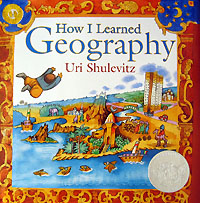|
|
|
|
|
|
|

| 최근 이 책을 구매하신 다른 회원의 책장 |
|
 |
|
|
|
[ 책 소개 ]
* Caldecott Honor 수상작
* ALA Notable Children's Books
* An Indie Next Kids' List Great Read
* Bank Street Best Children's Book of the Year
* CCBC Choice (Univ. of WI)
* New York Public Library Book for Reading and Sharing
* Parents' Choice Honor Books
* Charlotte Zolotow Award 수상작
* NCSS-CBC Notable Trade Book in the Field of Social Studies
* Booklinks Lasting Connection
* Booklist Editors' Choice
* Publishers Weekly Best Children's Books of the Year
* School Library Journal Best Books of the Year
* Capitol Choices Noteworthy Titles for Children and Teens
* Michigan Great Lakes Great Books Award Master List
* North Ward Elementary Favorite Picture Book
이 책을 비롯해서 Snow, The Fool of the World and the Flying Ship, The Treasure 등으로 네차례나 Caldecott상을 수상한 그림책의 거장인 Uri Shulevitz의 작품입니다. 국내에는 "내가 만난 꿈의 지도"라는 제목으로 번역서가 출간되었습니다.
전쟁 속에서 피어난 꿈과 희망에 관한 이야기이며 작가 유리 슐레비츠 자신의 이야기이기도 합니다. 제2차 세계 대전 때문에 유럽을 8년 동안이나 떠돌며 보낸 어린 시절의 저자의 경험이 담겨 있습니다. 작가는 책 속에서 어떤 힘든 상황에 처하더라도 꿈과 희망을 잃지 말라고 어린이들에게 말합니다.
모든 것을 피폐하게 만든 전쟁 속에서 주인공 아이의 삶 역시 예외는 될 수 없었습니다. 당장 먹을 것도 없는 가족들은 목숨을 겨우 부지해가면서 살아가던 어느 날, 아빠는 빵 쪼가리 대신 지도를 사옵니다. 배를 곯기 일쑤인 아이와 부인이 실망할 것을 알면서도 자신보다 살아갈 날이 많은 아이가 당장의 허기진 배를 채우는 것보다 희망으로 내일을 채우기 바랐기 때문입니다. 처음엔 아빠의 마음을 이해하지 못했던 아이는 한쪽 벽면을 가득 채운 커다란 세계 지도를 쳐다보면서 점점 지도 속으로 빠져들게 됩니다. 생소한 지명들을 이어서 라임을 만들기도 하고, 사막과 고산지역과 화려한 사원과 열대밀림과 고층건물이 들어찬 대도시로 상상 속의 여행을 떠나기도 합니다. 배고프고 비참한 삶 속에서 지도를 통해 아이는 환상적인 나날을 보낼 수 있었지요.
이 책은 아픈 현실들을, 단순히 피하는 것이 아니라 내면세계를 들여다봄으로써 이겨낸다는 점에서 큰 의미를 지니고 있습니다. 저자는 자신의 경험을 판타지와 접목시켰습니다. 아이가 발견한 지도 속에 숨어 있는 넓고도 아름다운 세계는 아이가 꿈꾸던 내면 세계와 맞닿아 있습니다. 유리 슐레비츠 특유의 담담한 화법과 그림이 펼치는 이야기가 감동적으로 펼쳐집니다.
[ 관련 동영상 보기 ]
 ▶
[ 서지 정보 ]
Hardcover: 32 pages
ISBN-10: 0374334994
ISBN-13: 978-0374334994
책 크기: 26cm x 26cm
[ 영문 서평 ]
Book Description
Having fled from war in their troubled homeland, a boy and his family are living in poverty in a strange country. Food is scarce, so when the boy’s father brings home a map instead of bread for supper, at first the boy is furious. But when the map is hung on the wall, it floods their cheerless room with color. As the boy studies its every detail, he is transported to exotic places without ever leaving the room, and he eventually comes to realize that the map feeds him in a way that bread never could.
The award-winning artist’s most personal work to date is based on his childhood memories of World War II and features stunning illustrations that celebrate the power of imagination. An author’s note includes a brief description of his family’s experience, two of his early drawings, and the only surviving photograph of himself from that time.
From School Library Journal Starred Review
Shulevitz provides a note and early drawings to source this story based on his own childhood experience. A small boy and his parents flee Poland in 1939. They travel to Turkestan (modern-day Kazakhstan) where they live in one room in a house made of "clay, straw, and camel dung" with strangers. When the narrator's father returns from the bazaar with a huge map instead of bread to feed his starving family, his wife and son are furious. But the map turns out to provide food for his spirit as the youngster becomes fascinated by its every detail. Using his imagination, he can transport himself to all of the exotic-sounding places on it without ever leaving the dreary room in which it hangs. The folk-style illustrations, rendered in collage, watercolor, and ink, combined with the brief text, create a perfectly paced story. A page turn to discover where Father is going "one day" brings readers into a Russian bazaar with its crowds of colorful sellers and buyers, the scene closely resembling a drawing the illustrator made at age 10. Scenes framed in white depict the family boxed in by their desperate circumstances, first fleeing their war-torn country with its angry red-black sky, and then cramped in their small room in a distant land. The frames disappear as the boy imagines himself released from his confinement to travel his newly discovered world. This poignant story can spark discussion about the power of the imagination to provide comfort in times of dire need.
From Booklist Starred Review
Recasting a childhood memory as a fictional tale, Caldecott Medalist Shulevitz revisits the journeying theme from his recent The Travels of Benjamin Tudela (2005), while harking back to the fanciful simplicity of Snow (1998) and So Sleepy Story (2006). Driven from home by a “war that devastated the land,“ a family flees to a remote city in the steppes. One day, the father returns from the market not with bread for supper but with a wall-filling map of the world. “‘No supper tonight,’ Mother said bitterly. ‘We’ll have the map instead.’” Although hungry, the boy finds sustenance of a different sort in the multicolored map, which provides a literal spot of brightness in the otherwise spare, earth-toned illustrations, as well as a catalyst for soaring, pretend visits to exotic lands. Shulevitz’s rhythmic, first-person narrative reads like a fable for young children. Its autobiographical dimension, however, will open up the audience to older grade-schoolers, who will be fascinated by the endnote describing Shulevitz’s life as a refugee in Turkestan after the Warsaw blitz, including his childhood sketch of the real map. Whether enjoyed as a reflection of readers’ own imaginative travels or used as a creative entrée to classroom geography units, this simple, poignant offering will transport children as surely as the map it celebrates.
Washington Post Book World
"Shulevitz's simply worded text can be read to preschoolers, but it packs an emotional punch that will resonate with older children and even adults. The watercolor and ink illustrations add further depth as Shulevitz switches from a monochrome palette to a chorus of colors spotlighting how the map stirred his imagination."
The Boston Globe
“Caldecott Medal winner Uri Shulevitz's newest picture book, How I Learned Geography, is really a love story for the world. It belongs to the newly popular genre of memoir as picture book. Shulevitz handles his autobiographical material with grace and humor. . . . Shulevitz always puts character at the forefront of his work. The expressions and gestures of his characters are believable, human-scale, and tender, full of dreaming."
|
|
|
|
|
 |
제품상제정보 배송/반품/교환 안내 |
|
|
|
Super Buy 도서는 미국 출판사의 재고도서(Remainder Book), 초과출간도서(Excess Inventory), 할인도서(Bargain Books)
등을 직수입해서 정가의 55%~80%를 할인한 가격에 판매하는 제품입니다.
Super Buy 책의 품질은 거의 새 책과 같은
수준이지만, 간혹 커버의 스크래치나 접힘과 같은 하자나, 책 하단의 재고도서 마크가 있을 수 있습니다.
저렴하게 판매하는 Super Buy 제품의 특성상 반품이 되지 않습니다만, 파본인 경우에는 착불로 반품하시면 책값을
환불해드리거나 적립금으로 올려드립니다. (반품 전에 연락 요망)
하프프라이스북에서는 중고도서(second hand book)를 취급하지 않습니다.
|
|
|
 - 등록된 128,139건의 서평이 있습니다. - 등록된 128,139건의 서평이 있습니다.
| 더보기 
|
|
|
|
|
|
|
 |
|
|
|
|
|
Vote!
An ALA Notable Chi..
3,900원 | | |
| |
| |
| |
|
|
Farm
Lift-the-Flap Tab,..
3,800원 | | |
| |
| |
|
|
|
|
|